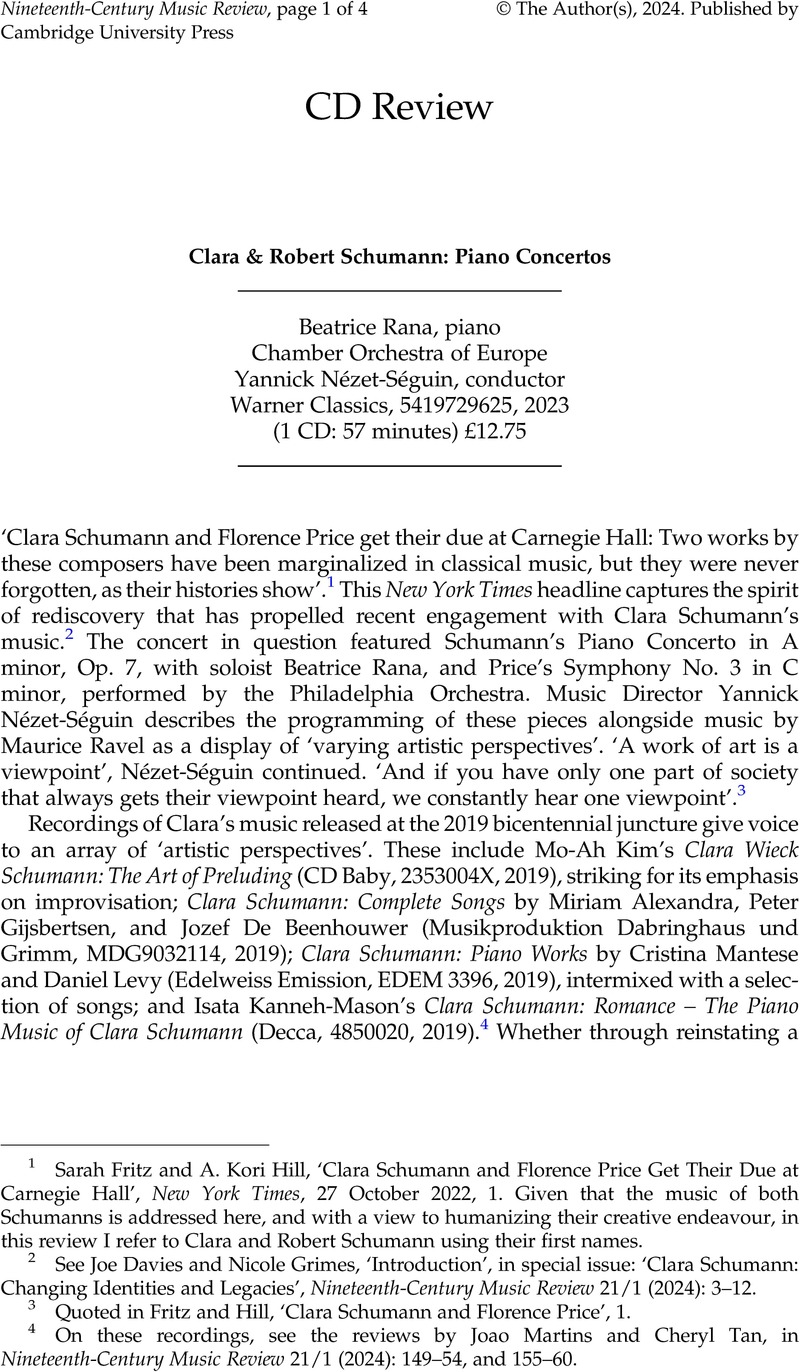No CrossRef data available.
Article contents
Clara & Robert Schumann: Piano Concertos Beatrice Rana, pianoChamber Orchestra of EuropeYannick Nézet-Séguin, conductorWarner Classics, 5419729625, 2023(1 CD: 57 minutes) £12.75
Review products
Published online by Cambridge University Press: 22 April 2024
Abstract

- Type
- CD Review
- Information
- Copyright
- Copyright © The Author(s), 2024. Published by Cambridge University Press
References
1 Sarah Fritz and A. Kori Hill, ‘Clara Schumann and Florence Price Get Their Due at Carnegie Hall’, New York Times, 27 October 2022, 1. Given that the music of both Schumanns is addressed here, and with a view to humanizing their creative endeavour, in this review I refer to Clara and Robert Schumann using their first names.
2 See Davies, Joe and Grimes, Nicole, ‘Introduction’, in special issue: ‘Clara Schumann: Changing Identities and Legacies’, Nineteenth-Century Music Review 21/1 (2024): 3–12Google Scholar.
3 Quoted in Fritz and Hill, ‘Clara Schumann and Florence Price’, 1.
4 On these recordings, see the reviews by Martins, Joao and Tan, Cheryl, in Nineteenth-Century Music Review 21/1 (2024): 149–54CrossRefGoogle Scholar, and 155–60.
5 See Mo-Ah Kim, ‘Towards a Revival of Lost Art: Clara Wieck Schumann's Preluding and Selected 20th-Century Pianist-Composers’ Approaches to Preluding’ (DMA dissertation, University of Cincinnati, College-Conservatory of Music, 2019).
6 Further on their programming choices, see the conversation between Beatrice Rana and Yannick Nézet-Séguin at www.warnerclassics.com/release/schumann-rana.
7 On this discourse, see Rodgers, Stephen, The Songs of Clara Schumann (Cambridge: Cambridge University Press, 2023): 16–23CrossRefGoogle Scholar; Davies, Joe, ‘Clara Schumann in the Musicological Imagination’, in Clara Schumann Studies, ed. Davies (Cambridge: Cambridge University Press, 2021): 1–12CrossRefGoogle Scholar, at 8; Parsons, Laurel and Ravenscroft, Brenda, ‘Introduction: “Half of Humanity Has Something to Say, Also”’, in Analytical Essays on Music by Women Composers: Secular and Sacred Music to 1900, ed. and, Parsons Ravenscroft (New York: Oxford University Press, 2017): 1–8Google Scholar; and Kenny, Aisling and Wollenberg, Susan, ‘Introduction’, in Women and the Nineteenth-Century Lied, ed. and, Kenny Wollenberg (Farnham: Ashgate, 2015): 1–10Google Scholar, at 6.
8 Stephen Rodgers, ‘Softened, Smudged, Erased: Punctuation and Continuity in Clara Schumann's Lieder’, in Clara Schumann Studies, 57–74, at 73.
9 See Joe Davies, ‘Clara Schumann and the Nineteenth-Century Piano Concerto’, in Clara Schumann Studies, 97–118; and Stefaniak, Alexander, Becoming Clara Schumann: Performance Strategies and Aesthetics in the Culture of the Musical Canon (Bloomington: Indiana University Press, 2021): 174–92CrossRefGoogle Scholar.
10 Joe Davies and Alexander Stefaniak, ‘Women, Pianos, and Virtuosity in the Nineteenth Century’, in The Cambridge Companion to Women Composers, ed. Matthew Head and Susan Wollenberg (Cambridge: Cambridge University Press, forthcoming): 205–26, at 214.
11 See Reich, Nancy B., Clara Schumann: The Artist and the Woman (Ithaca, NY: Cornell University Press, 1985, rev. 2001): 228Google Scholar.
12 Rana's approach complements Isata Kanneh-Mason's Romance: The Piano Music of Clara Schumann (Decca, 2019), where her Op. 7-ii is contextualized vis-à-vis her corpus of Romanzen – from the 3 Romances for solo piano, Op. 11 (1839), to the 3 Romances for Violin and Piano, Op. 22 (1853). For wider reference, see Katharina Uhde and R. Larry Todd, ‘Contextualizing Clara Schumann's Romanzen’, in Clara Schumann Studies, 165–86.
13 See Horton, Julian, Robert Schumann: Piano Concerto, New Cambridge Music Handbooks (Cambridge: Cambridge University Press, 2023)CrossRefGoogle Scholar; Stefaniak, Alexander, Schumann's Virtuosity: Criticism, Composition, and Performance in Nineteenth-Century Germany (Bloomington: Indiana University Press, 2016): 174–93CrossRefGoogle Scholar; and Reich, Clara Schumann, 227–8.
14 On its formal structure, see Taylor, Benedict, ‘Clara Wieck's A Minor Piano Concerto: Formal Innovation and the Problem of Parametric Disconnect in Early Romantic Music’, Music Theory and Analysis (MTA) 8/2 (2021): 215–43CrossRefGoogle Scholar.
15 Davies, ‘Clara Schumann and the Nineteenth-Century Piano Concerto’, 111–12.
16 See Toh, Deirdre, ‘Werktreue Ideology in Clara Schumann's and Franz Liszt's Piano Transcriptions’, Journal of the Society for Musicology in Ireland 18 (2023): 23–48CrossRefGoogle Scholar.





